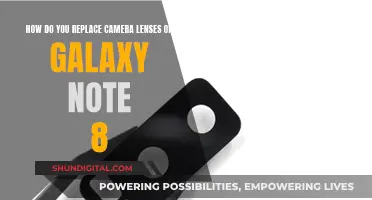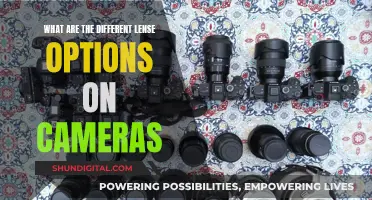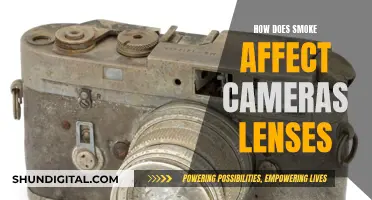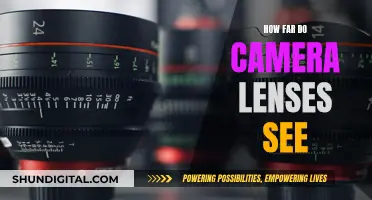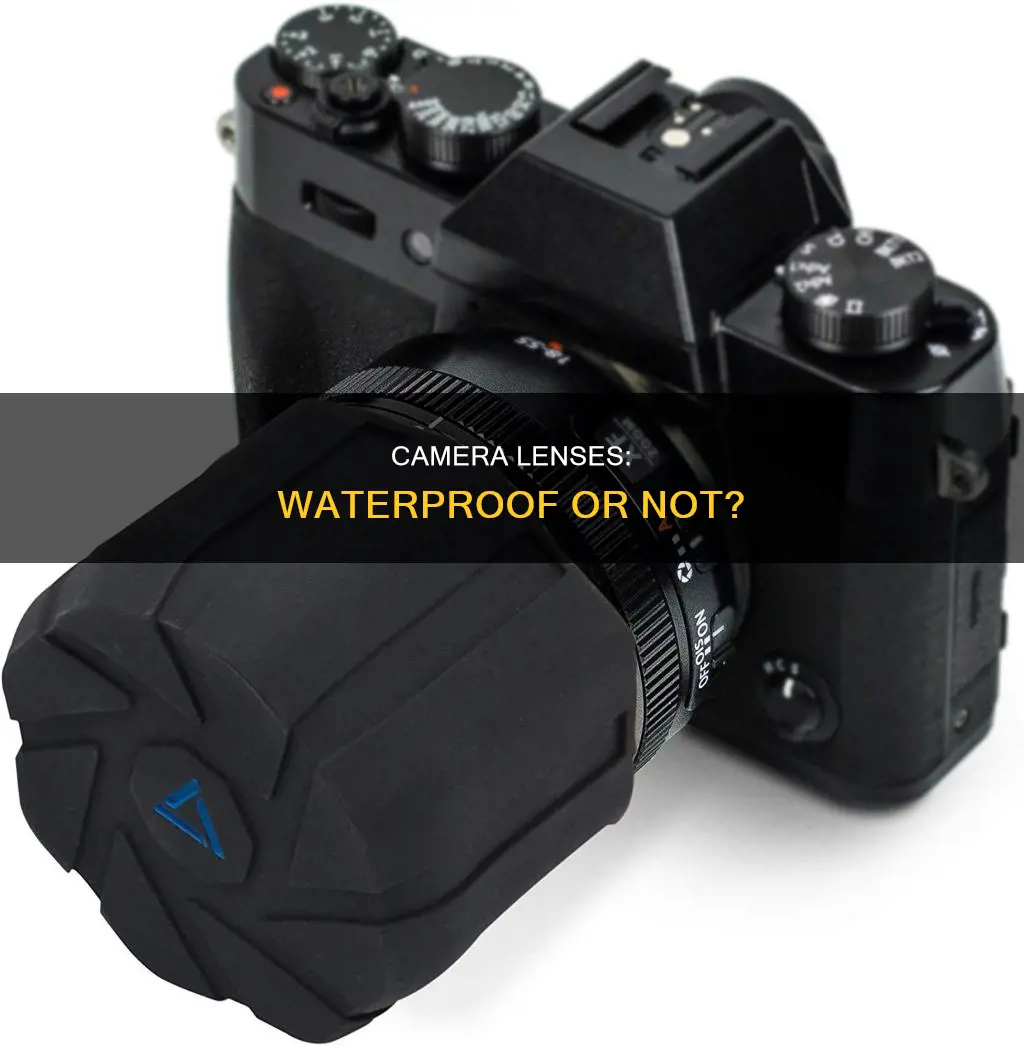
Camera lenses are not inherently waterproof, but many modern lenses offer varying degrees of water resistance through weather sealing and specialised design. Weather sealing is a protective measure that involves creating barriers to prevent water and dust from entering the lens's internal components. It is achieved through the use of rubber gaskets, overlapping materials, and lens coatings that repel water. While weather sealing does not make a lens completely waterproof, it provides enhanced protection in wet conditions. For photographers who require more specialised equipment, there are waterproof lens options available that are designed for extreme weather conditions or underwater environments. These lenses feature tighter seals and additional protective elements to ensure optimal performance.
| Characteristics | Values |
|---|---|
| Are camera lenses waterproof? | Camera lenses are not inherently waterproof. |
| Water resistance | Many modern lenses have varying degrees of water resistance. |
| Weather sealing | Weather sealing is a protective measure that involves creating barriers to prevent water and dust from entering the lens's internal components. |
| Factors affecting water resistance | Lens construction, materials used, and the design of internal seals all play a role in water resistance. |
| Specialized waterproof lens options | Specialized waterproof lenses are available for photographers working in extreme weather or underwater environments, providing enhanced water resistance and durability. |
| Protecting non-waterproof lenses | Non-waterproof lenses can be protected using lens hoods, filters, and camera rain covers in wet conditions. |
| Caring for water-exposed lenses | If a lens gets exposed to water, remove excess water with a dry cloth and air dry in a dust-free environment. Do not use heat sources to speed up drying. |
What You'll Learn

Camera lenses are not inherently waterproof
Weather sealing is a common feature in high-end DSLRs and mirrorless cameras, and it involves creating barriers to prevent the entry of water and dust into the internal components. This enhances the overall water resistance of the camera system, but it does not make the lenses or camera body completely waterproof. It is important to note that weather sealing does not imply that the equipment can be submerged or exposed to heavy rainfall without consequences.
The level of water resistance in a camera lens depends on various factors, including the construction and materials used. Lenses with metal or high-quality plastic exteriors and tight-fitting components tend to provide better resistance to water. Additionally, manufacturers may apply specialised coatings to lens elements to repel water and prevent droplets from adhering to the surface, further enhancing their water-resistant capabilities.
For photographers who frequently work in extreme weather conditions or underwater environments, specialised waterproof lens options are available. These lenses are specifically designed for challenging environments and provide enhanced water resistance and durability. They often feature tighter seals, additional protective elements, and specialised coatings to ensure optimal performance in wet conditions.
It is important to understand the limitations of your equipment and take appropriate precautions when shooting in wet environments. Using lens hoods, protective filters, umbrellas, and dedicated camera rain covers can provide additional protection for your lenses during heavy rainfall. Additionally, wiping off any moisture from the lens surface with a microfiber cloth after shooting in wet conditions is essential to prevent water damage.
How Camera Lenses Use Refraction to Capture Images
You may want to see also

Weather sealing does not mean a camera is waterproof
Weather sealing is a common feature in high-end cameras and even some consumer models. It typically involves rubber gaskets placed in the camera body and/or lens mount to prevent water, dust, and moisture from entering the equipment. However, it is important to note that weather sealing does not mean a camera is waterproof.
Weather sealing provides a level of protection against splashes of water and adverse weather conditions, such as rain, snow, and freezing temperatures. It helps to minimise the chances of water entering the camera through various buttons, dials, and mounts. However, it is not designed to withstand full submersion or prolonged exposure to water. Only waterproof cameras are built for such purposes.
While weather sealing offers some peace of mind when shooting in challenging conditions, it is not a guarantee against water damage. Manufacturers typically do not cover weather sealing damage in their warranties, and users should be cautious when exposing their equipment to water, even with weather sealing in place.
Additionally, weather sealing does not prevent condensation from forming inside the camera when moving between environments with significant temperature differences. To avoid condensation, one would need to fill the camera with dry air and seal it permanently, which is not practical for photography equipment that requires frequent lens changes.
In summary, while weather sealing provides some protection against water and moisture, it does not make a camera waterproof. Users should still take precautions to avoid full submersion or excessive exposure to water, as this could result in damage that may not be covered by the manufacturer's warranty.
How to Eclipse-Proof Your Camera Lens
You may want to see also

Water-resistant cameras and lenses are not the same as waterproof
Weather sealing, or water resistance, is a common feature of high-end cameras and lenses, and it allows photographers to capture images in challenging conditions. This sealing protects against rain, splashes of water, and snow, as well as dust and humidity. However, it is important to note that weather-sealed cameras and lenses are not designed to be submerged in water.
Waterproof cameras and lenses, on the other hand, are designed to be submerged and can be taken underwater to capture images. These cameras are completely sealed, with lenses that do not extend from the body and minimal moving external parts. They also feature a locking mechanism on the battery compartment to ensure it is closed before taking the camera underwater.
The distinction between water-resistant and waterproof equipment is crucial. While water-resistant lenses can handle some exposure to water, they are not designed to be submerged. For underwater photography, a waterproof camera and lens are necessary to ensure the equipment remains functional and images can be captured effectively.
It is also important to note that the terms "weatherproof" and "waterproof" are not interchangeable. Weatherproof cameras refer to those that can withstand challenging weather conditions, but they are not designed for underwater use. Waterproof cameras, on the other hand, specifically refer to those that can be submerged underwater.
The Ultimate Camera Lenses for Professional Photography
You may want to see also

Waterproof cameras are designed to function underwater
While most camera lenses are not inherently waterproof, there are specialised waterproof options available. These are specifically designed for underwater photography and can be used submerged.
High-end DSLRs and mirrorless cameras often come with weather-sealed bodies and lens mounts, but this does not mean they are waterproof. Weather sealing refers to the protective measure that involves creating barriers to the entry of water and dust into the camera's internal components. It is important to note that weather sealing does not make a camera or lens waterproof, and they cannot be submerged in water.
For photographers who require underwater capabilities, specialised waterproof lenses are available. These lenses are designed to function in challenging environments, providing enhanced water resistance and durability. They often feature tighter seals, additional protective elements, and specialised coatings to ensure optimal performance underwater.
It is crucial to understand the difference between weather sealing and waterproofing. Weather sealing makes a camera or lens resistant to moisture, splashes, and dust, but it does not make it waterproof. Submerging a weather-sealed camera or lens can result in damage that is typically not covered by the manufacturer's warranty.
In summary, while most camera lenses are not waterproof, specialised waterproof options exist for photographers who require underwater capabilities. These lenses are designed to function underwater, providing enhanced water resistance and durability.
Understanding Camera Lens Interchangeability: What You Need to Know
You may want to see also

Practical tips for protecting non-waterproof camera lenses
Camera lenses are not inherently waterproof, so it's important to take steps to protect them from water damage. Here are some practical tips for safeguarding your non-waterproof camera lenses:
- Use lens hoods and protective filters: Lens hoods and filters can provide a physical barrier, shielding the front element of your lens from rain, splashes, and other moisture.
- Invest in an umbrella or rain cover: For added protection during heavy rainfall, consider using an umbrella or a dedicated camera rain sleeve or cover. These accessories will help keep your gear dry and protected.
- Wipe down the lens: After shooting in wet conditions, use a microfiber cloth to gently wipe down the lens surface and remove any moisture. This simple step can prevent water spots and streaks from forming on your lens.
- Allow the lens to air dry: If your lens does get wet, use a dry cloth to remove excess water, and then let the lens air dry in a dust-free environment. Avoid using heat sources to speed up the drying process, as this can potentially damage the lens.
- Consider weather sealing: While it doesn't make your lens waterproof, weather sealing can provide some protection against moisture and dust. Look for lenses with rubber gaskets and tight-fitting components, which tend to offer better water resistance.
- Use a waterproof housing: If you plan to submerge your camera in water, consider investing in a waterproof housing specifically designed for your camera model. This will ensure that your camera and lens remain dry and protected.
- Consult a professional: If you suspect any internal damage to your lens after exposure to water, it is advisable to consult a professional camera technician for further guidance and repair.
By following these practical tips, you can help protect your non-waterproof camera lenses from water damage and ensure they remain in optimal condition for capturing images in various environments.
Lens and Camera Compatibility: Universal Fit or Not?
You may want to see also
Frequently asked questions
Camera lenses are not inherently waterproof. However, many modern lenses come equipped with varying degrees of water resistance or weather sealing.
You can use lens hoods, filters, umbrellas, rain covers, or dedicated camera rain sleeves to protect your lens from moisture.
Signs of water damage in a lens may include fogging, condensation, or blurry spots on the lens elements.




